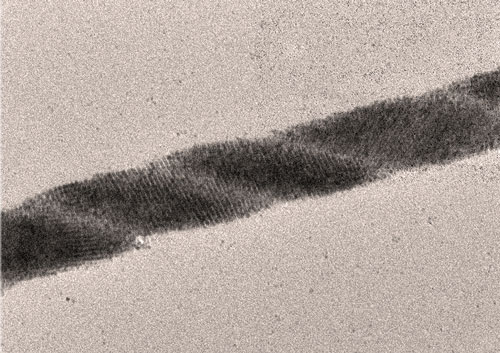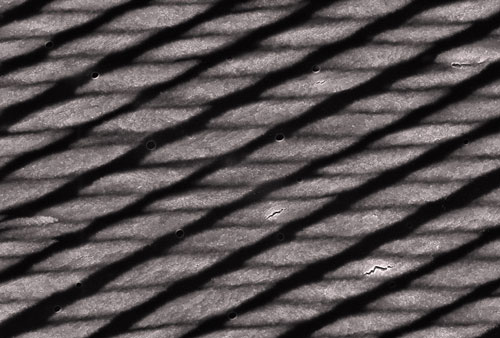| Posted: Aug 04, 2014 | |
A design guide to self-assemble magnetite nanoparticles into exotic superstructures |
|
| (Nanowerk Spotlight) Magnetite is the most abundant magnetic mineral of the Earth and magnetite particles are used in numerous products and applications – inks, magnetic liquids, and medical contrast agent, but also as memory elements in data storage media. Nanoscale magnetite has been extensively investigated by scientists during the past decades, also in the context of self-assembly. | |
| For millions of years, magnetite nanoparticles have been synthesized by magnetotactic bacteria – as well as by a variety of other species: birds, fishes etc. – where they self-assemble into fine needles which serve as an internal 'compass', allowing them to orient themselves along the lines of the magnetic field of the Earth. | |
| Researchers have now shown that, by varying the shape of magnetite nanoparticles, they can control the nature of the self-assembled structures as the nanoparticles assemble. This new work provides guidelines for the design of new self-assembled materials. | |
| Magnetite nanoparticles are essentially very tiny magnets, which can interact with each other by magnetic dipole-dipole interactions – in addition to other types of forces. | |
| "We had envisioned that cubic nanoparticles of magnetite would self-assemble differently from other shapes. The reason is that the properties of magnetite – specifically, so-called magnetocrystalline anisotropy, that is, preferential magnetization along given crystallographic orientation – tell us that when two cubes interact by magnetic forces, they could align in a corner-to-corner fashion," Rafal Klajn, an Assistant Professor in the Department of Organic Chemistry at the Weizmann Institute of Science, explains to Nanowerk. "On the other hand, when particles assemble, they also want to maximize contact (van der Waals interactions) which entails a side-to-side arrangement of two cubes. Therefore we have a 'competition' of two types of forces that want to align nanoparticles in different ways. This competition can lead to the emergence of exotic shapes: in our case, helices." | |
 |
|
| Transmission electron micrograph of an individual self-assembled helix. (Image: Gurvinder Singh) | |
| Klajn's group reported their observation on the emergence of helical nanoparticle superstructures during the self-assembly of superparamagnetic nanocrystals in the July 24, 2014 online edition of Science Express ("Self-assembly of magnetite nanocubes into helical superstructures"). For this work they collaborated with a theory group led by Petr Kral at the University of Illinois at Chicago. | |
| The team is broadly interested in the self-assembly of nanoparticles as a route to obtain novel functional materials. They note that materials self-assembled from nanoparticles often have fascinating optical, magnetic, catalytic, and other properties, in particular when the nanoparticles are assembled into non-close-packed lattices. | |
| "Self-assembly of nanoparticles driven by competing forces can result in truly unique structures, the diversity and complexity of which could be particularly striking if the building blocks were simultaneously coupled by short- and long-range forces of different symmetries," says Klajn. | |
| In this report, the team shows that it is possible to rationally design such 'frustration' during self-assembly of nanoparticles, thereby producing exotic superstructures/assemblies. This is probably the first method to self-assemble nanoparticles into helical assemblies without the use of any (i.e. helical) templates. | |
| At the same time, it is a way to assemble achiral building blocks into chiral assemblies, whereby symmetry breaking and chirality amplification is observed. | |
 |
|
| Scanning electron micrograph of an array of helices. (Image: Gurvinder Singh) | |
| Klajn points out that it actually is quite striking that, given all the previous research on magnetite nanoparticles, helical assemblies of magnetite nanoparticles – which form spontaneously when the solvent is evaporated in the presence of the magnetic field – are reported only now. | |
| Although this paper is about a fundamental discovery and, at this point, the research is quite away from any applications, the scientists think these materials could interact with light in very interesting ways; they should also have interesting magnetic properties. | |
| "In addition" says Klajn, "the fact that they are helical and chiral, and can be prepared very quickly and cheaply, makes them excellent candidates for templates for the assembly of other materials. They also could be coupled with achiral catalysts to produce catalysts that could potentially be chiral: that is, potential application in asymmetric catalysis." | |
| Having shown that the competition between magnetic and van der Waals interactions leads to unprecedented helical assemblies, the next step for the group is to add more types of interactions to the overall balance of forces in an effort to produce even more exotic assemblies. | |
| Another direction is the use of different materials. "Up to now we only worked with magnetite; there are a host of other magnetic nanoparticles – e.g. cobalt, nickel – that can behave similarly," says Klajn. "But the main focus in the future will be on novel properties/functions/applications enabled by these self-assembled materials." | |
 By
Michael
Berger
– Michael is author of three books by the Royal Society of Chemistry:
Nano-Society: Pushing the Boundaries of Technology,
Nanotechnology: The Future is Tiny, and
Nanoengineering: The Skills and Tools Making Technology Invisible
Copyright ©
Nanowerk LLC
By
Michael
Berger
– Michael is author of three books by the Royal Society of Chemistry:
Nano-Society: Pushing the Boundaries of Technology,
Nanotechnology: The Future is Tiny, and
Nanoengineering: The Skills and Tools Making Technology Invisible
Copyright ©
Nanowerk LLC
|
|
|
Become a Spotlight guest author! Join our large and growing group of guest contributors. Have you just published a scientific paper or have other exciting developments to share with the nanotechnology community? Here is how to publish on nanowerk.com. |
|
